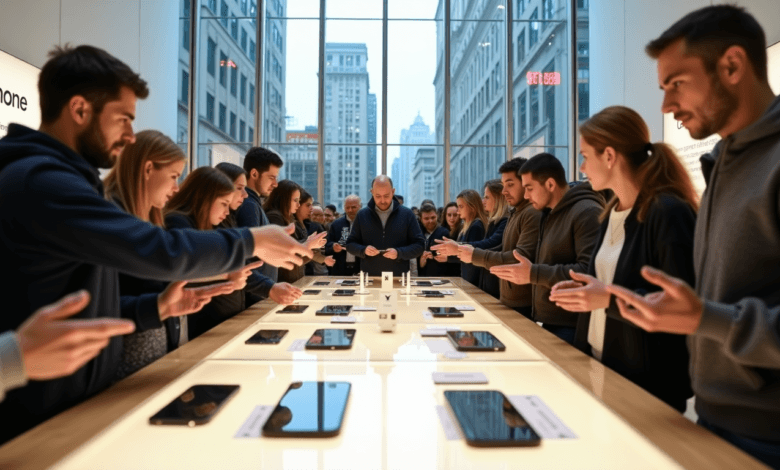
Your favorite Apple iPhone might soon cost you almost twice as much. Rosenblatt Securities analysts predict new tariffs could push iPhone prices up by 43%. The entry-level iPhone 16’s price could jump from $799 to $1,142. The premium iPhone 16 Pro Max could reach approximately $2,300, up from its current $1,599.
The price surge comes from a 54% tariff on Chinese imports that will affect Apple’s entire product line. Apple sells more than 220 million iPhones each year in major markets like the United States, China, and Europe. Though the company has moved some production to India and Vietnam, China remains their main manufacturing hub. These changes will have lasting effects on consumers and investors.
Trump Imposes 54% Tariff on Chinese Imports, Threatening iPhone Prices
President Trump’s sweeping tariff announcement will lead to unprecedented price hikes for Apple products. The new measures will add a 54% tariff on goods from China, where about 90% of iPhones sold worldwide come from [1]. Trump’s new plan will raise the current 20% rate to 34% [1].
How the new tariffs specifically target Apple products
These new tariffs will hit Apple’s carefully planned manufacturing strategy hard. The company spent years trying to reduce its reliance on Chinese manufacturing by moving production to Vietnam and India. Now Apple faces tariffs in multiple countries at once [2]. The tariffs don’t just target China (54%) but also extend to Vietnam (46%) and India (26%), which undermines Apple’s efforts to spread out its risks [2].
Apple will see its annual costs rise by $8.50 billion without any relief from the Trump administration. This could cut company profits by about $7.85 billion next year – taking a 7% bite out of projected earnings [1]. Apple’s stock has already dropped 5.7% since Trump made his announcement [1].
Analysts predict iPhone 16 Pro Max could reach $2,300
Money experts have different views on how these tariffs will push consumer prices up. UBS analysts think the iPhone 16 Pro Max could cost up to $350 more for units made in China, pushing retail prices up by nearly 30% [3]. Rosenblatt Securities analysts say iPhone prices might jump by as much as 43% if Apple passes these costs to buyers [4].
The premium iPhone 16 Pro Max with 1TB storage now costs $1,599 but could reach about $2,300 based on these estimates [5]. The base iPhone 16e might go from $599 to $856 if Apple applies the 43% increase [5].
Timeline of tariff implementation and potential escalation
Trump calls it “Liberation Day” and wants these tariffs to start right away [6]. The total rate could hit a massive 104% if Trump follows through with the extra 50% tariff on Chinese imports as promised [7].
Apple might have enough inventory stored up to keep current prices until Memorial Day (May 26), according to some analysts [5]. Morgan Stanley analysts say Apple could handle extra tariff costs of about $34 billion yearly, but point out that the company has less room to maneuver since other manufacturing locations will face big tariffs too [3].
JPMorgan Chase analysts think Apple might raise global prices by 6% to deal with U.S. tariffs [3]. Angelo Zino at CFRA Research believes the company won’t pass more than 5% to 10% of the cost to customers [5]. Most experts expect major price changes to come with the iPhone 17 launch this fall [5].
Consumers Rush to Buy Apple iPhone 15 and 16 Before Price Hikes
US retail stores have seen a surprising rush of customers who want to buy iPhones before prices go up. Apple’s store employees say their locations are “packed with customers” who worry about upcoming price increases [8].
Retail stores report ‘panic buying’ comparable to holiday season
Apple’s retail locations buzz with energy that matches the usual holiday shopping rush [9]. Customers are “panic-buying phones,” according to one employee who noted almost everyone asks about future price changes [8]. The stores haven’t seen typical new-iPhone-launch lines, but sales numbers have jumped substantially during what should be a quiet season [9].
Weekend sales at Apple’s US stores hit higher numbers on April 5-6 compared to past years [8]. This sales jump stands out because new iPhones don’t usually arrive until September [9]. Rather than waiting for the next model, many customers choose to upgrade now because they fear big price jumps in the weeks ahead [4].
Apple stockpiles devices to maintain current pricing temporarily
Apple has gotten ready for tariff effects by managing its inventory smartly. The company’s fleet of five planes brought iPhones and other devices from India to the US just in the last week of March [8]. The tech giant also shipped extra units from China during what should have been a slow production time [8].
This aggressive stockpiling has filled US warehouses with enough products to last several months [10]. Apple wants to keep current prices steady for now by building up inventory before new tariffs kick in [10].
Products already in US warehouses won’t face new tariffs, which might let Apple hold off price increases until September’s iPhone launch [11]. Manufacturing has moved to countries like India and Vietnam, but these locations can’t make enough phones to meet all US demand [12]. The extra inventory only buys Apple time as it works out a long-term plan to handle the tariff challenge.
How Much Will Your Next iPhone Actually Cost?
The numbers show exactly how much your next iPhone will cost under the new tariff structure. Financial analysts have calculated price increases that could double the cost of some models in Apple’s lineup.
Entry-level iPhone 16e could jump from $599 to over $1,200
Apple’s most affordable smartphone, the iPhone 16e, priced at $599, faces price hikes that would end its budget-friendly status. Rosenblatt Securities analysts expect a 43% increase that would push the price to about $856 [4]. The price could reach $1,222 if Apple transfers the full tariff cost to customers [13]. This makes the entry-level model more expensive than today’s standard iPhone 16 ($799).
Premium models face steepest increases
The biggest price jumps will hit high-end iPhones. The iPhone 16 Pro base model’s price could rise from $999 to $1,400 [14]. The premium iPhone 16 Pro Max with 1TB storage might jump from $1,599 to almost $2,300 [14][15]. UBS analysts predict a 30% retail price increase for China-manufactured units [3]. Wedbush analyst Dan Ives notes that US-manufactured iPhones would cost about $3,500 due to higher production costs [16][3].
Payment options and their true costs
Apple provides several ways to manage these higher prices:
- Split the cost over 24 months at 0% APR (currently $24.95/month for iPhone 16e) [17]
- Extend to 36-month payment plans through carrier financing [17]
- Get carrier credits between $800-$1,000 with eligible trade-ins [17]
These financing options spread the higher costs over time but don’t reduce the total amount. Apple processes your first installment payment within three days of purchase [18].
Trade-in values may increase to offset sticker shock
Apple might boost trade-in values through its Apple Trade In program to keep sales strong [19]. You can exchange Apple and third-party devices for credit toward new purchases. The company requires trade-ins within 14 days of receiving your new device [19]. Apple will give you a revised trade-in value if your device’s condition differs from your description, which you can accept or decline [19].
Apple Stock Price Plummets as Investors Fear Reduced Demand
The tariff announcement sent financial markets into turmoil and caused Apple’s share price to plummet. The company faces a critical challenge as investors worry that tariffs will reduce iPhone sales and other Apple products when the company needs strong revenue to counter rising costs.
20% drop since tariff announcement
Apple’s market value dropped by nearly $640 billion as shares lost about 20% in just three trading days [20]. The massive selloff started right after Trump’s tariff announcement, with the stock falling 5.7% in aftermarket trading following the original statement [1]. Thursday, April 3 saw a 9.3% decline – Apple’s worst single-day performance since March 2020 [21]. The share price fell below $180 by Monday, April 7, dropping from its pre-announcement level of $223.89 [5].
Analyst projections for sales volume effect
Shrinking profit margins have forced financial experts to significantly lower their Apple price targets. Wedbush Securities analyst Daniel Ives reduced his 12-month target from $325 to $250 [7]. Several analysts have calculated varying effects on Apple’s earnings per share (EPS):
- Morgan Stanley expects profits to decrease by 7% in 2026, roughly $7.85 billion [1]
- Woodring projects a 12% EPS reduction with mitigation efforts or 26% without [22]
- Needham analyst Laura Martin sees earnings dropping by 28%, lowering EPS by over $2.00 from current estimates [22]
- Barclays predicts up to 15% EPS reduction [3]
The analysts assume Apple will increase prices to offset costs, but they doubt the company can transfer all costs to consumers without severely hurting demand.
Comparison to previous tariff effects during first Trump administration
Apple managed better during Trump’s first term. CEO Tim Cook developed a relationship with Trump that helped Apple avoid tariffs on most products [1]. U.S. trade officials kept iPhones tariff-free and removed them from Apple Watches [1]. Cook’s commitment to significant U.S. investment appeared to protect Apple from severe tariff effects.
Analysts now estimate Apple has only a 30% chance of receiving a tariff exemption, despite its recent $500 billion U.S. spending commitment over four years [22].
Conclusion
Apple now faces major challenges with Trump’s new tariffs that could reshape the smartphone market. Your next iPhone might cost 43% to 104% more, which means premium models could reach beyond $2,300. Retail stores have seen a surge in sales as customers rush to buy devices before the price increase.
Apple has stockpiled inventory that might protect customers from these increases temporarily. Market experts expect big price changes by fall 2024. The company’s stock has already taken a hit, dropping 20% and wiping out $640 billion of its market value.
These tariffs show a dramatic change from Apple’s earlier dealings with the Trump administration. Market experts give only a 30% chance of getting any relief, unlike previous exemptions. Smart phone buyers should plan for higher prices, with base models starting at $856 and premium versions going above $2,300. These changes show how smartphones are becoming less affordable for tech enthusiasts and regular users across the US.




